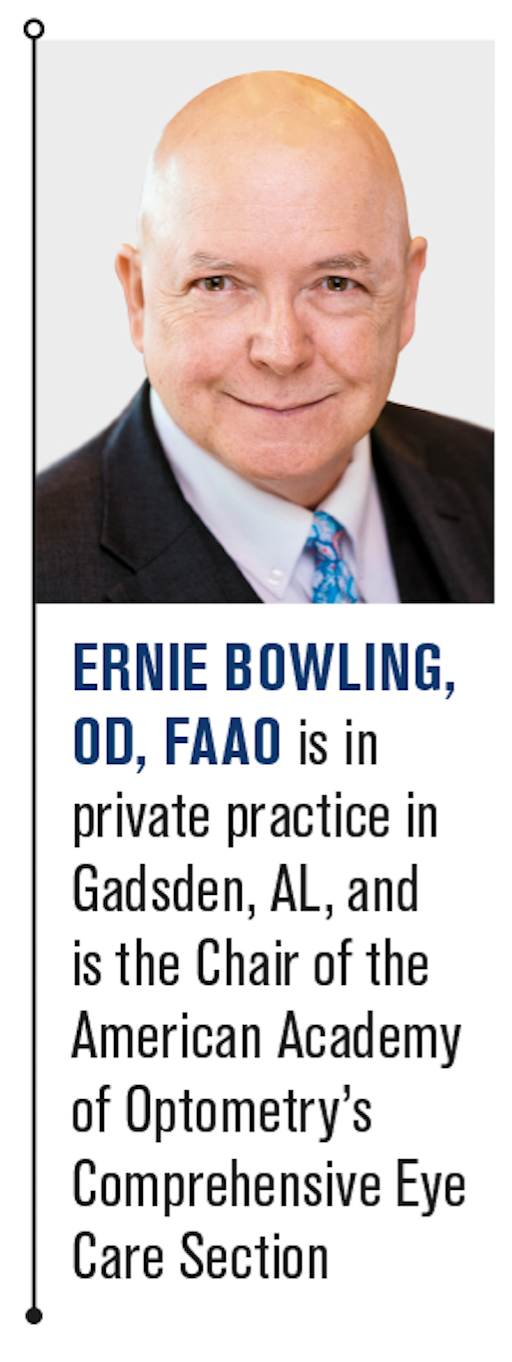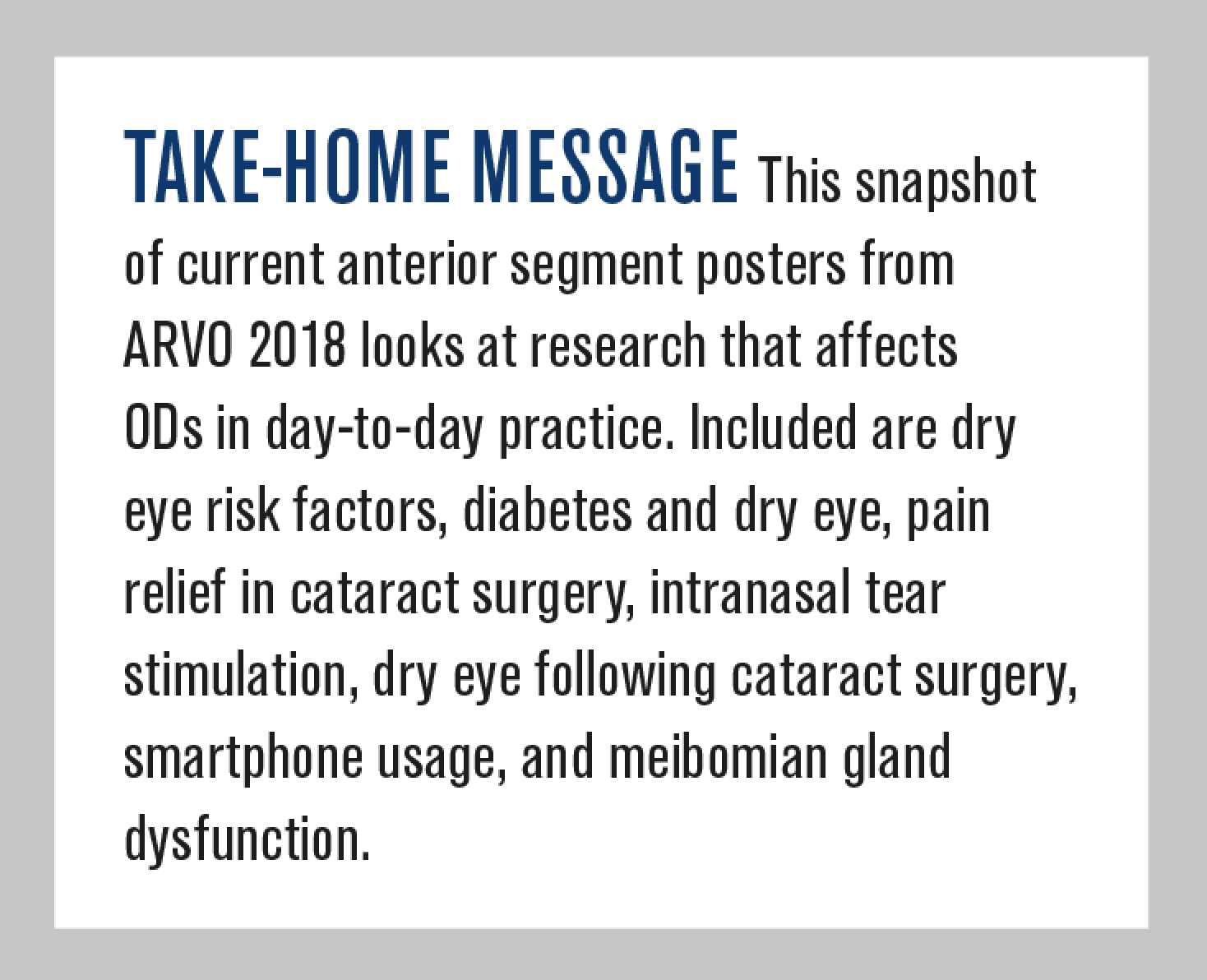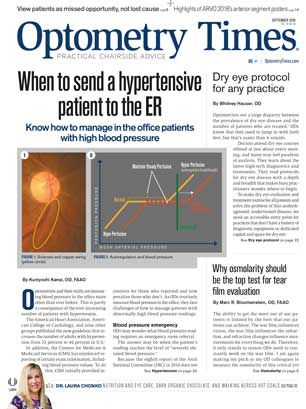Highlights of ARVO 2018’s anterior segment posters


Researchers in countless labs and clinics around the globe work hard to expand the knowledge base of eye care. Sometime in the future, the results of this research will enhance our patient care.
There is no better place to glean the results of this research than the annual Association for Research in Vision and Ophthalmology (ARVO) meeting.
I highlight some of the many posters presented during this year’s meeting (April 29-May 3, 2018, in Honolulu), concentrating on anterior segment reports of clinical relevance to practicing optometrists.
Dry eye risk factors
Researchers for a large-scale study in London of almost 80,000 participants investigated the association between dry eye disease (DED) and medication classes and individual drugs.1 The study revealed the highest risk for DED lies with these classes of drugs: anti-glaucoma drugs, drugs for functional gastrointestinal disorders, psychostimulants for attention deficit hyperactivity disorder (ADHD), drugs for a peptic ulcer, constipation, and urologicals.
Individual drugs showing the highest risk of DED were mebeverine, methylphenidate, pantoprazole, omeprazole, isphagula, and risedronic acid.
Interestingly, hydrochlorothiazide and the oral contraceptive ethinyl estradiol were associated with fewer dry symptoms.
Related: Why you should add upper lid eversion to your comprehensive exam
Another study conducted by optometrists updated the risk factors for DED.2 New risk factors were identified, including seeing a doctor regularly, sinus problems, migraines, and use of eye drops. A dry risk assessment (DERA) was used to determine the degree of agreement between clinical investigators and the model. Some 72.8 percent of agreement occurred between what investigators and DERTA determined was dry eye. The authors concluded this dry risk calculator “can help assess which individuals in the population might require testing and treatment.”
A study from Australia explored the interactions between lifestyle factors and menstrual cycle on the ocular surface of healthy young women.3 Researchers concluded that the effect appeared to be more pronounced during the ovulation phase as compared to the follicular and luteal phases of the menstrual cycle.
Diabetes and dry eye
Diabetes significantly impacts the body as a whole and can compromise organ systems, including the eye. Does diabetes make a difference in dry eye?
A group of optometrists conducted a multicenter study from seven different sites.4 The group concluded that while there is a strong overlap in signs and symptoms of diabetes associated with DED, differences exist in staining and self-reported redness. The study also showed a large percentage (51.3 percent) of dry eye in patients with diabetes goes undiagnosed based on Dry Eye Workshop (DEWS) II criteria. The authors acknowledge dry eye is often diagnosed in the diabetic population, and these patients may have different signs and symptoms due to vascular changes when compared to non-diabetics.
Related: How diabetes affects your patients
Researchers from the United Kingdom assessed the relationship between the severity of DED and the quality of life in people with diabetes.5 DED symptoms were noted in 58.8 percent of subjects with diabetes. The severity of DED was significantly higher in those with diabetes vs. controls.
In this study, DED was not associated with duration of diabetes, HbA1C level, or diabetic retinopathy; however, there was a strong positive association between the severity of the DED and its effect on quality of life of diabetic study participants. The authors recommended that those with diabetes should be routinely checked for dry eye during routine eye examinations.
Meibomian gland dysfunction and diabetes
Meibomian gland dysfunction (MGD) has been observed in Type 2 diabetics. Several posters attempted to quantify this association.
A prospective study of 76 subjects found that 76 percent of diabetics presented with MGD.6 Using the Ocular Surface Disease Index (OSDI) questionnaire, researchers found that symptoms were significantly higher in the diabetic group. The diabetic group showed major changes in lids and tear function, accounting for evaporative dry eye and presenting a high degree of correlation with meibomian gland inflammation and obstruction.
Related: Understanding the link between MGD and OSD
A study in China found that MGD was a major cause of DED and Type 2 diabetics without obvious aqueous tear deficiency.7 Unlike the previous study, this group found tear function and MGD parameters were correlated with HbA1C levels and diabetic duration. They conclude that MGD, which appears before the development of ocular discomfort, may be an early sign and the critical factor of dry eye in Type 2 diabetics.
Smartphone use
ODs have heard much discussion lately about smartphone use and dry eye. One group attempted to determine if smartphone usage affected dry eye.8
Using a novel open-field binocular tear film analyzer, designed to enable real-time measures of non-invasive tear break-up time (NIBUT) and blink rate (BR), the group studied 33 participants reading a novel on four different platforms: Apple iPhone 6, Apple iPhone 6S, Samsung Galaxy S6, and printed paper.
The study found that BR was reduced when subjects read on all three smartphones compared to reading paper. In addition, the results were indicative of a possible influence of smartphones on NIBUT changes, but those were isolated numbers. Tear film osmolarity values were similar when reading on all four platforms.
A study from The University of New South Wales studied the effects of 60 minutes of smartphone use in ocular symptoms, tear function, blinking, and binocular vision in 12 teenagers.9
Eye strain and discomfort were reported after reading on a smartphone for 60 minutes. These eye symptoms were accompanied by an increased blink rate and reduced ability to easily change focus. Such signs differ from those occurring with desktop computer use. The distance at which the study participants held the smartphone from their eyes was closer than the viewing distance usually adopted when reading from a book or desktop computer. The authors concluded “eye symptoms which occur due to smartphone use may have a different basis than eye symptoms experienced with using a desktop computer.”
Clinical signs in dry eye
Clinical signs of dry eye may be found using minimally invasive tests, yet their clinical use is limited by a lack of knowledge of their diagnostic value and by poor association with the symptoms of dry eye.
A group of Italian researchers performed a multicenter cross-sectional study of 397 patients to investigate low-tech clinical sign profiles in dry eye patients.10 Burning and foreign body sensation were the most frequently reported symptoms. The most frequent eyelid abnormalities were hyperemia, bridge vessels across the eyelid margin, and lid notching.
The most frequent conjunctival abnormalities were nasal staining, hyperemia, and conjunctivochalasis. The most frequent corneal abnormality was inferior staining, While the most frequent tear film abnormalities were reduced tear break-up time, a reduced tear meniscus, an irregular tear meniscus, a dirty tear film, and reduced tear secretion.
Authors of the many posters about the Dry Eye Assessment and Management (DREAM) study set out to determine the degree of correlation between clinical signs and patient symptoms of dry eye disease when assessed using standard procedures.11
Some 535 DED patients at 27 clinical centers were included in the study. The authors concluded that the measurable, objective signs of DED do not correlate with the subjective symptoms that cause DED and the reason people go to the doctor seeking relief.
Demodex prevalence was studied in patients with dry eye disease.12 Researchers studied 73 patients with mild to severe dry eye and found Demodex to be present in 43.8 percent of those patients. They also found that Demodex became more frequent with increasing age, the lower lid was more often affected, male patients were more often infected than female patients.
The authors concluded that “patients with meibomian gland dysfunction, posterior blepharitis, increased loss of eyelashes, or the occurrence of asymmetrical cylinders should be investigated for Demodex infestation.”
Warm compresses and MGD
Eyelid warming treatments have become popular therapies for MGD. Several posters examined warm compress therapies.
One study compared the ability of four commercially available lid heating devices to increase eyelid temperature and tear film lipid layer thickness.13 The researchers found that all devices tested raised the temperature of the inner eyelids, but not by equal amounts.
LipiFlow heated the inner eyelid is more than the other devices. The post treatment increase in lipid layer thickness was similar with the Bruder device, Blephasteam and LipiFlow, while MiBo ThermoFlo had the smallest lipid layer thickness increase. Neither of the devices altered corneal topography.
Related: Using warm compresses to treat meibomian gland disease
Beaded mass or less expensive option and more convenient than face cloth compresses, hands are more commonly recommended by eye care practitioners.
Another study determined how the temperature of the Bruder Moist Heat Eye Compress device varied as a function of time in the microwave.14 In this study the Bruder mask did not reach a consistent temperature even when using the same microwave, mask, and heating times. This study showed that heating a beaded mask according to manufacturer’s directions resulted in inconsistent temperatures and may heat the masks to the point to cause thermal damage to eyelid tissues.
The authors concluded that “the popularity of beaded masks is increasing, but practitioners and consumers alike should be aware that their use could be harmful.”
Intranasal tear stimulation
Several posters addressed TrueTear, Allergan’s intranasal tear neurostimular (ITN) device.
A study evaluated the durability of dry eye symptom relief following daily use of the device in 54 subjects completing the study.15 The eye dryness score, ocular discomfort score, and Schirmer tear test showed statistically significant improvement with the device use. In addition, a statistically significant improvement in dry eye disease symptoms was found after 45 days of ITN use.
The authors concluded, “the sustained ability to increase tear production and reduce dry eye symptoms positions the ITN as a promising new management strategy for dry eye disease.”
Other researchers studied the effect of TrueTear on dry eye symptoms during exposure to a controlled adverse environment in 143 subjects.16 They found that during controlled adverse environment exposure, a single application of the ITN device produced a statistically significant improvement in dry eye disease symptoms.
In both studies the device was well tolerated.
Cataract surgery
Most optometrists comanage cataract patients. Several posters addressed questions I had about cataract surgery.
Having undergone the procedure myself in both eyes over the last year, one of my questions was about sedation. I had intravenous (IV) sedation for both procedures, but I wondered if I might have gone without it. Evidently, I'm not alone.
A group of Canadian researchers assessed the effectiveness of IV vs. non-IV sedation methods in phacoemulsification.17 Some 10 studies of 985 subjects were included in their data analysis. Their research indicated that IV sedation resulted in less pain and more patient comfort compared to non-IV sedation, yet a subgroup analysis of a small number of studies indicated that oral sedation and IV sedation techniques may be equivalent in controlling patient pain.
The results of this study have a potential to impact cataract surgery costs because switching from IV sedation to oral sedation may result in immense cost savings.
Read more about cataract surgery
Dry eye following cataract surgery is a concern for patients. A study evaluated the frequency and risk factors for persistent post-surgical pain (PPP) after cataract surgery, defined as mild or greater dry eye-like symptoms six months after surgery.
Some 32 percent of subjects reported PPP. Ten percent reported severe symptoms.18 Patients with dry eye-like symptoms after cataract surgery also exhibited higher ocular pain scores and specific ocular complaints (including ocular burning and sensitivity to light and wind) compared to controls with no symptoms. Mild or greater PPP occurred in about a third of patients following cataract surgery.
The prevalence of severe PPP is in line with that of refractive surgery, dental implants, and genitourinary procedures.
References:
1. Wolpert L, Bazeer S, Hammond CJ, Vehof J. A hypothesis-free study of medication use and symptomatic dry eye in 79,866 participants. Invest Ophthalmol Vis Sci. 2018 July;59(9):958. Available at: https://iovs.arvojournals.org/article.aspx?articleid=2693623&resultClick=1. Accessed 9/5/18.
2. Kwan J, Harthan JS, Doll T, Schwartz S, Halleran C, Hauswirth SG, O’Dell LE, Schachter S, Mastrota M, Bernabe N, Hom M. Dry eye risk assessment (DERA): predictive value of newly identified risk factors. Invest Ophthalmol Vis Sci. 2018 July;59(9):4861. Available at: https://iovs.arvojournals.org/article.aspx?articleid=2692381&resultClick=1. Accessed 9/5/18.
3. Colorado L, Edwards K, Dinh L, Ha S, Liu D, Luu A, Trang S. Yu-Ting, TH, Schmid KL. Lifestyle factors and menstrual cycle phases: impact on dry signs and symptoms. Invest Ophthalmol Vis Sci. 2018 July;59(9):4903. Available at: https://iovs.arvojournals.org/article.aspx?articleid=2692412&resultClick=1. Accessed 9/5/18.
4. Schwartz S, Halleran C, Doll T, Harthan JS, Williams MT, O’Dell LE, Bernabe N, Hom M. Does diabetes make a difference in dry eye? Invest Ophthalmol Vis Sci. 2018 July;59(9):956. Available at: https://iovs.arvojournals.org/article.aspx?articleid=2689675&resultClick=1. Accessed 9/5/18.
5. Hagan S, Byambajav M, Elshein R, Collier A, Jonuscheit S. Quality of life and dry eye disease severity in people with diabetes. Invest Ophthalmol Vis Sci. 2018 July;59(9):4865. Available at: https://iovs.arvojournals.org/article.aspx?articleid=2692383&resultClick=1. Accessed 9/5/18.
6. Garzon JJ, Lopez-Alemany A. Effects of diabetes type two on meibomian glands, ocular surface and tear function. Invest Ophthalmol Vis Sci. 2018 July;59(9):4862. Available at: https://iovs.arvojournals.org/article.aspx?articleid=2694150. Accessed 9/5/18.
7. Wu H, Xie F, Luo S, Zhirong L, Liu Z, Shang X, Liu Z. Meibomian gland dysfunction is an early sign and major cause of dry eye in type 2 diabetes. Invest Ophthalmol Vis Sci. 2018 July;59(9):4900. Available at: https://iovs.arvojournals.org/article.aspx?articleid=2692410&resultClick=1. Accessed 9/5/18.
8. Buckhurst PJ, Afzam Shan Bin Abduk Rhaim M, Purslow C, Buckhurts HD. Investigating the influence of using smart devices on the ocular accommodative response. Invest Ophthalmol Vis Sci. 2018 July;59(9):2945. Available at: https://iovs.arvojournals.org/article.aspx?articleid=2690922&resultClick=1. Accessed 9/5/18.
9. Golebiowski B, Long J, Harrison K, Asper L. Smartphone use and effects on tear film, blinking and binocular vision. Invest Ophthalmol Vis Sci. 2018 July;59(9):913. Available at: https://iovs.arvojournals.org/article.aspx?articleid=2689645&resultClick=1. Accessed 9/5/18.
10. Cantalmessa E, Villani E, Nucci P, Rolando R. Clinical signs and dry eye: a multicentric cross-sectional study. Invest Ophthalmol Vis Sci. 2018 July;59(9):4871. Available at: https://iovs.arvojournals.org/article.aspx?articleid=2692388&resultClick=1. Accessed 9/5/18.
11. Pistilli M, Maguire MG, Greiner JV, Asbell PA. The association between signs and symptoms in patients with dry eye disease. Invest Ophthalmol Vis Sci. 2018 July;59(9):924. Available at: https://iovs.arvojournals.org/article.aspx?articleid=2693621&resultClick=1. Accessed 9/5/18.
12. Jacobi C, Kurz JK, Paulsen FP, Juenemann AGM. Demodex folliculorum in patients with mild to severe dry eye. Invest Ophthalmol Vis Sci. 2018 July;59(9):4869. Available at: https://iovs.arvojournals.org/article.aspx?articleid=2692386&resultClick=1. Accessed 9/5/18.
13. Stetson G, Kenrick C. A comparison of four warm compress devices. Invest Ophthalmol Vis Sci. 2018 July;59(9):953. Available at: https://iovs.arvojournals.org/article.aspx?articleid=2689672&resultClick=1. Accessed 9/5/18.
14. Nau A, Stetson G. Temperature variability of beaded heat mask for meibomian gland dysfunction. Invest Ophthalmol Vis Sci. 2018 July;59(9):940. Available at: https://iovs.arvojournals.org/article.aspx?articleid=2689662&resultClick=1. Accessed 9/5/18.
15. Penzner J, Hollander DA, Torkildsen G, Baba S, Holdbrook M, Senchyna M. Evaluation of the durability of dry eye symptom relief following daily use of TrueTear. Invest Ophthalmol Vis Sci. 2018 July;59(9):914. Available at: https://iovs.arvojournals.org/article.aspx?articleid=2689646&resultClick=1. Accessed 9/4/18.
16. Senchyna M, Ousler GW, Jenkins G, Pattar G, Evans D, Holdbrook, M, Baba S. Effect of TrueTear on dry eye symptoms during exposure to a controlled adverse environment. Invest Ophthalmol Vis Sci. 2018 July;59(9):918. Available at: https://iovs.arvojournals.org/article.aspx?articleid=2689650&resultClick=1. Accessed 9/4/18.
17. Kiatos E, Armstrong JJ, Hutnik CML, Tsioros S, Malvankar M, Hodge W. A systematic review and meta-analysis of intravenous sedation in modern cataract surgery. Invest Ophthalmol Vis Sci. 2018 July;59(9):4778. Available at: https://iovs.arvojournals.org/article.aspx?articleid=2692319&resultClick=1. Accessed 9/5/18.
18. Gibbons A, Iglesias E, Sajnani R, Levitt R, Sarantopoulos K, Galor A. Epidemiology of persistent dry eye-like symptoms after cataract surgery. Invest Ophthalmol Vis Sci. 2018 July;59(9):942. Available at: https://iovs.arvojournals.org/article.aspx?articleid=2689664&resultClick=1. Accessed 9/5/18.

Newsletter
Want more insights like this? Subscribe to Optometry Times and get clinical pearls and practice tips delivered straight to your inbox.